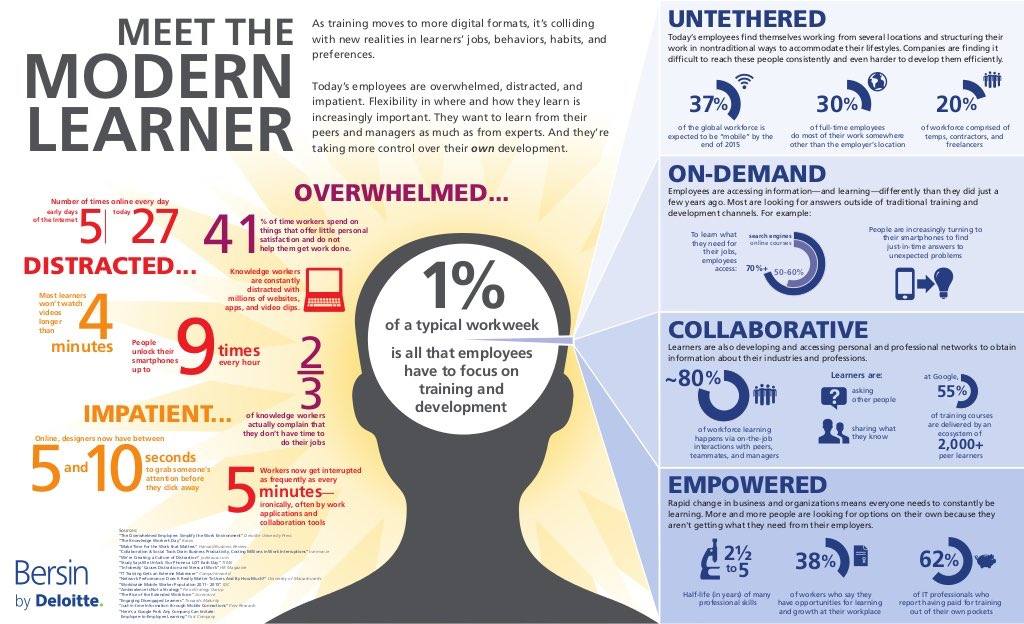Over the past 40 years, the way we provide professional development for educators has changed. From one-shot, sit-and-get sessions based on what we wanted to offer to individualized learning experiences based on what each teacher or administrator wants or needs to learn, we’ve come a long way! But the latest data on adult learners may show that we need to go even further.
The Pressures on Adult Learners
The infographic below from Bersin by Deloitte has a number of interesting and relevant findings. While the information is gathered from all types of adult workers, it applies equally to school folks. Let’s take a look at the data to see how it should impact the way we provide professional learning for educators.

Key Points about Professional Development for Today’s Adult Learner
Make Sure to Address WIIFM (What’s In It For Me): Ensure that the learning content is focused on driving behaviors and impacting work performance. The thing that matters most to today’s learners is that we answer their question, “How’s this going to help me perform better and faster on the job?” We can’t take time to teach them a “cool tool” or show them a “great website” unless it can really affect learning in the classroom.
Offer Learning in Short Bursts: The average adult learner today can only spend 24 minutes a week focusing on training and development due to the demands of his job. In addition, he will only watch a video that’s four minutes in length or less. Add to that the fact that we have only five to 10 seconds to get someone’s attention in an online web page like a Google Site. All of those facts together mean that the learning we provide must be in short chunks. We should take our old six-hour workshop and break it down into many, many, many, MANY small pieces. Think micro. Think active learning (and that doesn’t mean just getting up and walking around). Think collaborative. Think reflective. (By the way, this same approach works perfectly with students today as well.)
Eliminate Distractions: With so little time and available mind space for learning new things, we need to make sure that we have eliminated any distractions in the work environment that are not useful. Too many meetings? Give your adult learners information via email or short video clips instead. Ditto for morning announcements that take up too much time. When they are able to attend a PD event, make sure to streamline everything so that critical learning is front and center. This may include introducing ourselves and our background (they don’t really care) and those fun icebreakers we love to do (not needed as much if the learning is individualized).
Think Outside the School Building/Day: Provide ways for your adult learners to learn 24/7 when they want and can do so. Online courses, video clips, recorded webinars, infographics, how-to handouts are all excellent ways to provide information while allowing participants the freedom to decide when and where they are ready to learn.
Put the Learning in a Mobile Format: Adult learners today check their cell phones an average of nine times an hour. We are glue to these devices. So provide your professional development in a format that works on a cell phone screen. Ways to do this include:
- Have one idea/topic per screen.
- Start with existing slides or a PDF, if you already have them in your content files, and break them down into smaller pieces.
- Have modules that take less than 10 minutes to complete.
- Include lots of visuals.
- Ensure that the content is formatted to load faster, i.e. no large graphics or videos.
- Have easy navigation like large buttons and obvious directions of what should be done next.
Provide an Online Place for Collaboration: 80% of learning now happens via on-the-job interactions with peers and 70% of employees access answers to on-the-job questions through search engines. Your educators are looking for solutions. So give them a way to get those solutions from people who really know what they are talking about: other educators. Whether you have a district Facebook group or you provide membership in TCEA for all of your staff so that they can collaborate and learn from others in the Community, it’s important for you to do something that facilitates their conversations about teaching and learning. Google may be great for answering many questions, but it doesn’t often contain true solutions that work in our classrooms.
If we keep these important points in mind, our adult learners will be empowered to learn at each of them needs to, which will help to ensure that the learning is transferred and continued in the classroom.

